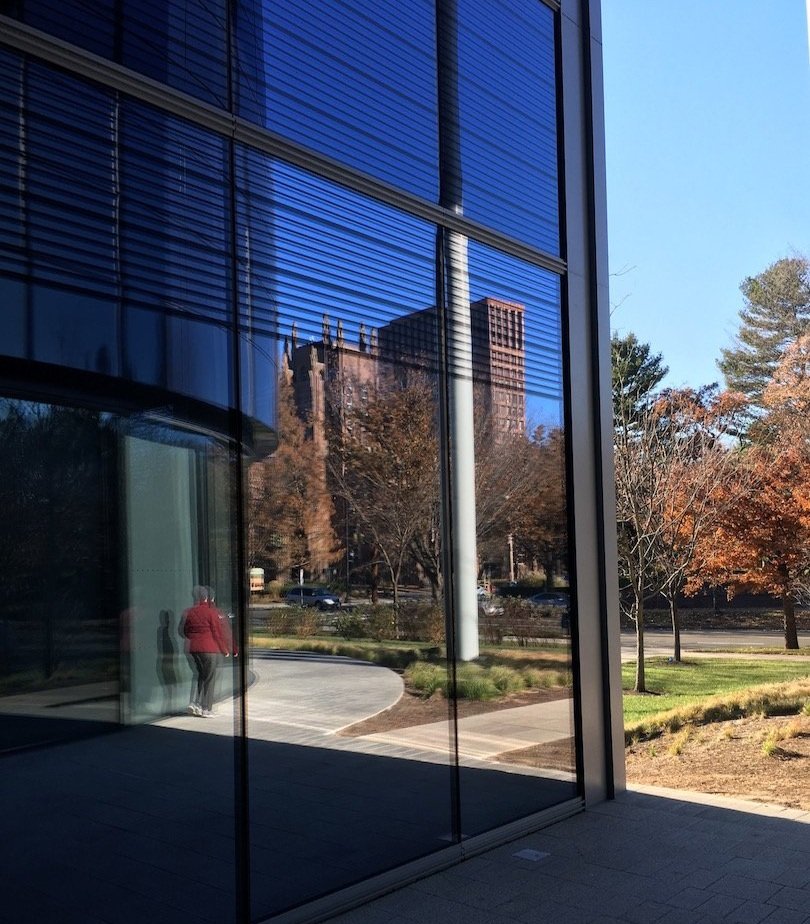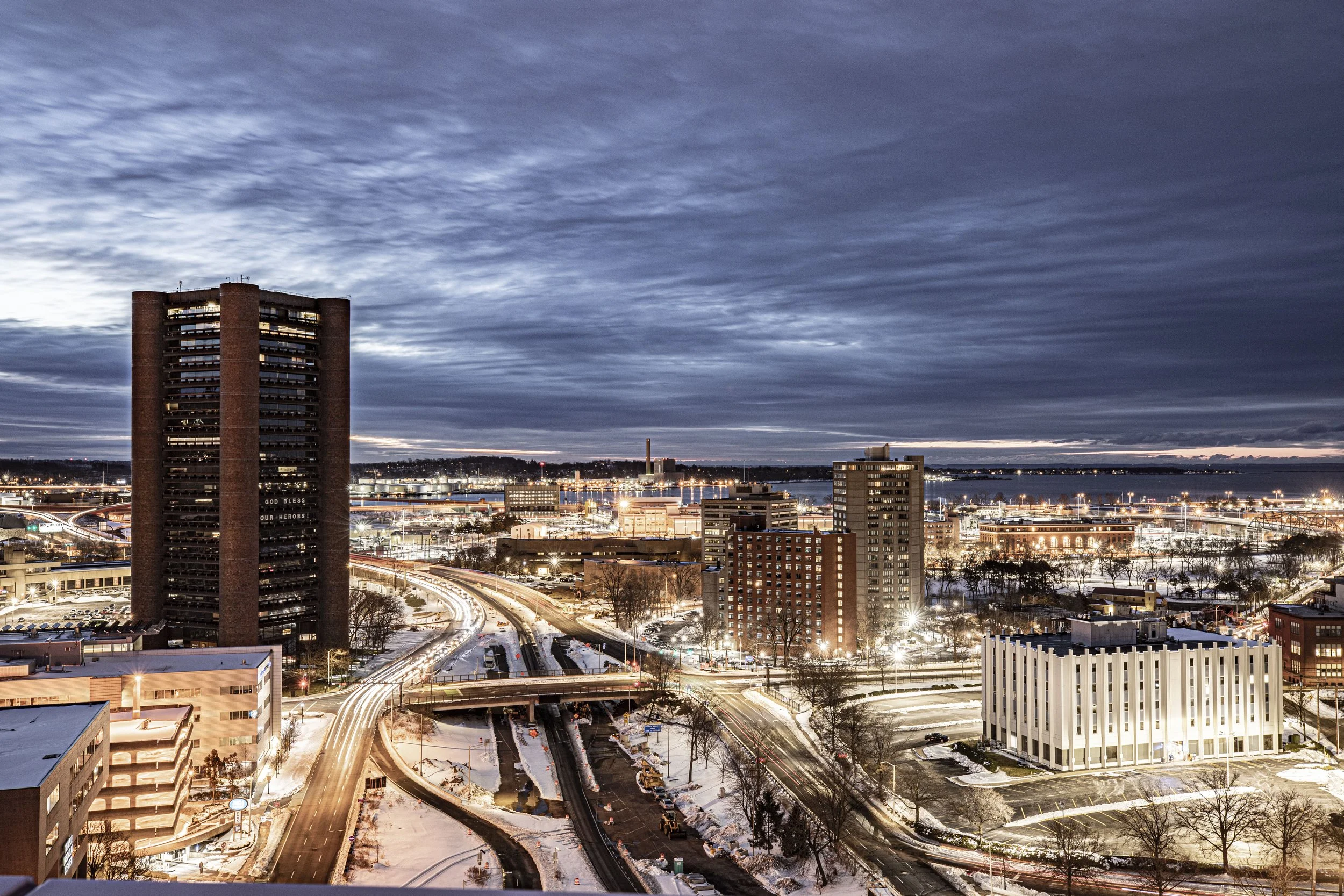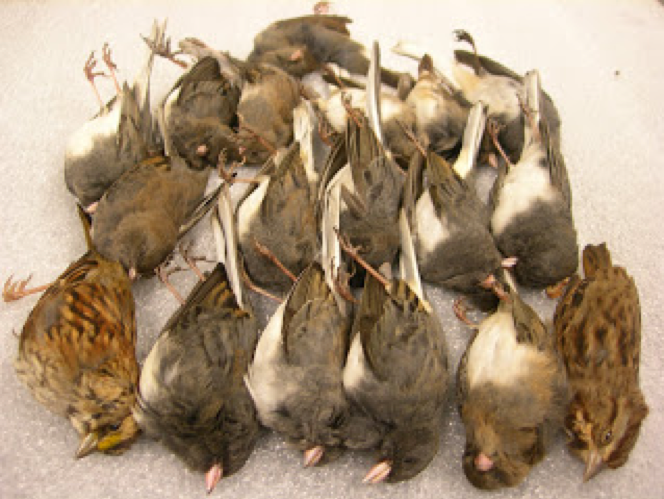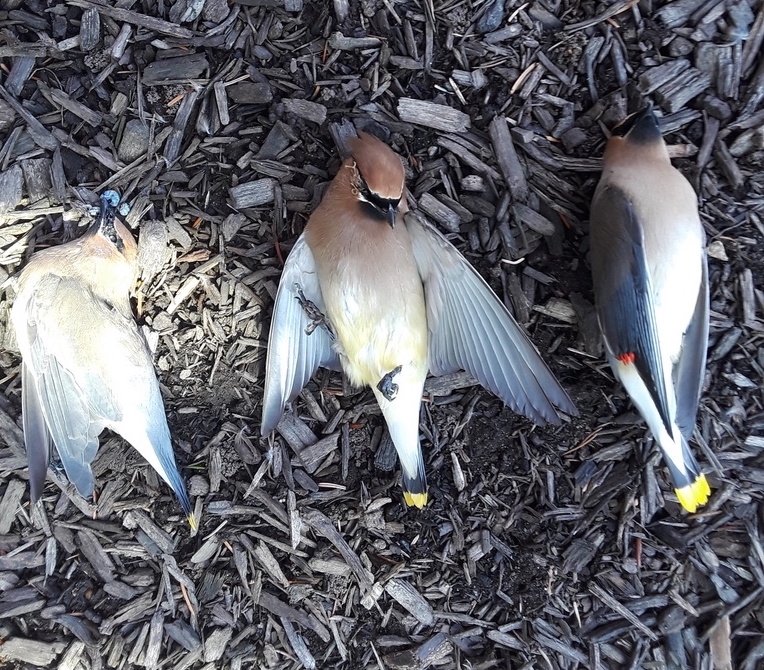
FAQ
Are bird window collisions a problem on Yale’s campus?
Yes. Many of Yale’s older buildings feature stained glass, mullions, and other design characteristics that make them easy for birds to see and avoid. But at many modern buildings on Yale’s campus with glass windows or glass facades, bird-window collisions occur often. Hundreds, and perhaps thousands, of birds are killed every year by colliding with Yale buildings.
Yale Peabody Museum staff and the Yale West Campus grounds crew together picked up 52 dead birds on West Campus in a single day. Photo by Lynn Jones.
For example, more than 400 birds of more than 50 species were recorded killed or injured due to collisions with the Yale School of Management’s Evans Halls from April 2018 to April 2022, according to data collected by Yale researchers, facilities staff, and citizen scientists. It is conservative to estimate that this single Yale building will kill many thousands of birds over the course of its lifetime if the building is not retrofitted for bird safety. Happily, these deaths are preventable with bird-friendly design and materials, and landscaping and lighting choices that take wild birds into account. With over 520 owned and leased buildings, the university has many opportunities to help protect birds.
Three unlucky cedar waxwings, killed by window collisions in April 2022 at 344 Winchester Avenue in New Haven, CT. Photo by iNaturalist user scoenh (cc-by-nc).
Newly constructed buildings at Yale are required to meet LEED gold certification standards. Why is that not enough to protect birds?
LEED certification does not require the use of bird-safe design or bird-safe materials. Ironically, many new LEED buildings feature large glass facades and other design choices that can make structures particularly deadly to wild birds. Examples of LEED-certified buildings at Yale that are known to receive frequent bird collisions include the Yale School of Management Evans Hall (165 Whitney Avenue), the Yale Sculpture Buildings (32-36 Edgewood Avenue), and the Yale Science Building (260 Whitney Avenue).
In 2023, the University updated its building design requirements for new and significantly remodeled buildings to include bird-friendly design standards. Buildings are currently being constructed that adhere to these standards. However, these standards do not apply retroactively to existing buildings, so many university structures continue to kill large numbers of birds. One of our research goals is to understand how effective the current standards are and to propose updated institutional design standards if needed to ensure the standards are effective and reflect current science.
The Yale School of Management’s Evans Hall, designed by Foster + Partners, opened in 2014. Despite being certified as a LEED Gold building, the building kills staggering numbers of birds. More than 430 birds of more than 50 species died due to collisions with the building from 2018 to 2022. Photo by Chuck Choi, Yale University.
The Yale Science Building, designed by Pelli Clarke Pelli Architects, opened in 2019. Birds of more than a dozen species have died by colliding with the building, according to citizen science and Peabody Museum data. Killed species include Connecticut warblers, famously hard-to-find birds. Photo by Paul Coco, Yale University.
The Yale Sculpture Building, designed by Kieran Timberlake, is another LEED-certified building on Yale’s campus that frequently kills birds. Some of the killed birds were memorialized in an ongoing sculpture series by Yale School of Art alumna Selva Aparacio. Photo by Enzo Figueres, Creative Commons (cc-by-2.0).
Why do bird-window collisions occur?
Simply put, most birds can’t see most glass. Scientists estimate that around or more than 1 billion birds die by flying into windows every year in the United States, making windows a leading driver of human-caused bird deaths.
Building size, architectural design, the use and type of glass, lighting design, and landscaping choices make some buildings particularly deadly for birds. For example, birds are often lured to their death by reflective glass abutting habitat and by transparent glass through which they can see habitat or open sky. Learn more about the science of bird-window collisions from American Bird Conservancy.

TRANSPARENT GLASS: Transparent glass often appears invisible to birds. Glass through which birds can see habitat frequently lure birds to their deaths. Dozens of birds have died colliding with the both sides of this walkway at Yale’s Evans Hall.

REFLECTIVE GLASS: Glass that mirrors the surrounding landscape and open sky can create an optical illusion for birds, triggering collisions.

ARTIFICIAL LIGHT: Most bird-building collisions occur in the daytime. However, light pollution can contribute indirectly to increasing collisions by attracting migrating birds to bright, developed environments where they are more likely to encounter, and collide, with buildings. Photo by Dan Renzetti, Yale University.
What can be done to prevent bird collisions?
There are many effective, affordable, and attractive solutions to significantly reduce bird mortality at new and existing buildings. Some of these solutions can also save money and improve energy efficiency. Importantly, many of these solutions do not require sacrificing aesthetics, functionality, ease, or budget.
Effective bird-friendly solutions include netting, fritted glass, UV-treated glass, louvers, window screens, artistic etching, patterned window films, patterned window markers, frosted glass, and more. American Bird Conservancy (ABC) and NYC Audubon provide many helpful resources that explain the science behind bird-window collisions, provide numerous examples of bird-friendly design in practice, and rate the effectiveness of solutions:
Bird-Friendly Building Guide (NYC Audubon and ABC)
Bird-friendly building materials and design choices are already widespread in the industry, and many architects have been at the forefront of calling for bird-safe building standards. For example, New York’s chapter of the American Institute of Architects was among the vocal supporters of and advocates for New York City’s bird-friendly building legislation.
Have other universities implemented bird-friendly design retrofits?
Yes. Many universities and major institutions have retrofitted buildings at large scale to reduce bird collisions. Examples of these institutions include: Northwestern University; University of Pennsylvania; Duke University; University of British Columbia; York University; the Javitz Convention Center in New York; and the Walter E. Washington Convention Center in Washington, D.C., among others.
Is bird-friendly building design required by law?
It is for some buildings in some places. Bird-friendly building legislation in the United States started in 2008 in Cook County, Illinois, with the unanimous approval of legislation proposed by U.S. Congressman Mike Quigley, who was then a member of the county’s Board of Commissioners. Since then, around two dozen jurisdictions across America – including states, cities, and towns – have proposed and/or passed bird-friendly building legislation, according to American Bird Conservancy.
Cities that have adopted bird-safe design requirements or voluntary guidelines include New York, NY; San Francisco, CA; Berkeley, CA; San Jose, CA; Oakland, CA; Santa Cruz, CA; Highland Park, IL; Minneapolis, MN; and Portland, OR. According to ornithologist Christine Sheppard, a leading expert on bird-window collision science and policy, bird-friendly building ordinances must answer three key questions: (1) What structures are covered by the ordinance? (2) How much and what portions of each structure must be “bird-friendly”? and (3) How is “bird-friendly” defined? The answers to these questions vary significantly among the existing bird-friendly building laws. One of our research goals is to better to understand how effective these laws have been and the experiences of the jurisdictions in charge of enforcing them.
I found a dead bird due to a window strike. What should I do?
Please take photos and report it! This citizen science data is very valuable for both science and advocacy. Instructions for how to report a bird collision are here.




